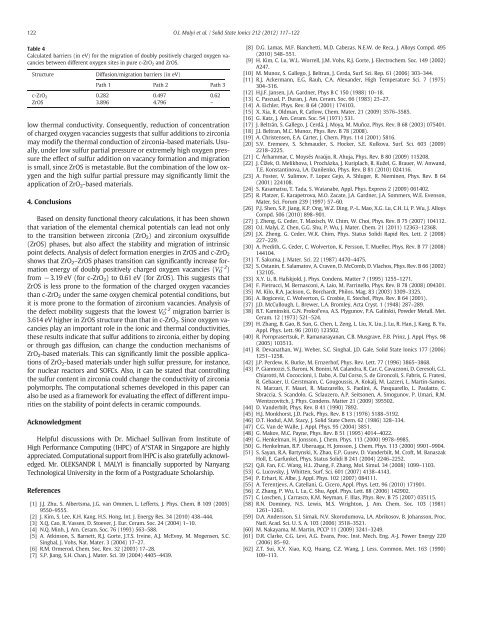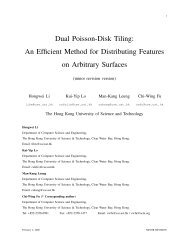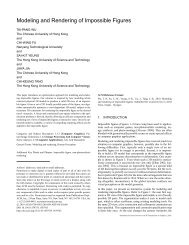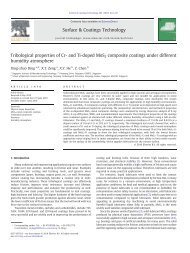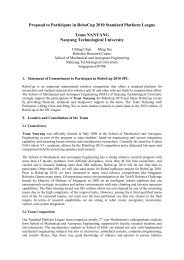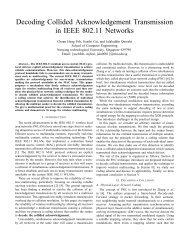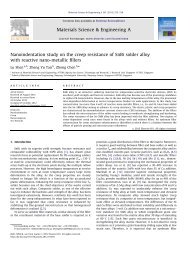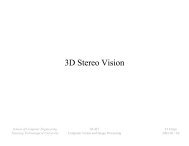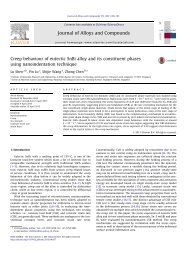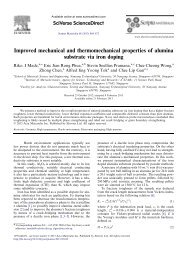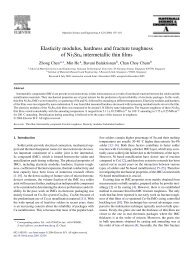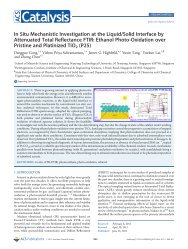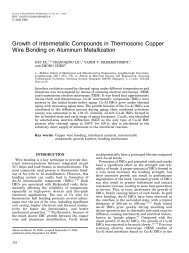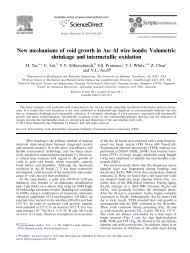Formation and migration of oxygen and zirconium vacancies in ...
Formation and migration of oxygen and zirconium vacancies in ...
Formation and migration of oxygen and zirconium vacancies in ...
You also want an ePaper? Increase the reach of your titles
YUMPU automatically turns print PDFs into web optimized ePapers that Google loves.
122 O.I. Malyi et al. / Solid State Ionics 212 (2012) 117–122<br />
Table 4<br />
Calculated barriers (<strong>in</strong> eV) for the <strong>migration</strong> <strong>of</strong> doubly positively charged <strong>oxygen</strong> <strong>vacancies</strong><br />
between different <strong>oxygen</strong> sites <strong>in</strong> pure c-ZrO 2 <strong>and</strong> ZrOS.<br />
Structure Diffusion/<strong>migration</strong> barriers (<strong>in</strong> eV)<br />
Path 1 Path 2 Path 3<br />
c-ZrO2 0.282 0.497 0.62<br />
ZrOS 3.896 4.796 –<br />
low thermal conductivity. Consequently, reduction <strong>of</strong> concentration<br />
<strong>of</strong> charged <strong>oxygen</strong> <strong>vacancies</strong> suggests that sulfur additions to zirconia<br />
may modify the thermal conduction <strong>of</strong> zirconia-based materials. Usually,<br />
under low sulfur partial pressure or extremely high <strong>oxygen</strong> pressure<br />
the effect <strong>of</strong> sulfur addition on vacancy formation <strong>and</strong> <strong>migration</strong><br />
is small, s<strong>in</strong>ce ZrOS is metastable. But the comb<strong>in</strong>ation <strong>of</strong> the low <strong>oxygen</strong><br />
<strong>and</strong> the high sulfur partial pressure may significantly limit the<br />
application <strong>of</strong> ZrO 2-based materials.<br />
4. Conclusions<br />
Based on density functional theory calculations, it has been shown<br />
that variation <strong>of</strong> the elemental chemical potentials can lead not only<br />
to the transition between zirconia (ZrO2) <strong>and</strong> <strong>zirconium</strong> oxysulfide<br />
(ZrOS) phases, but also affect the stability <strong>and</strong> <strong>migration</strong> <strong>of</strong> <strong>in</strong>tr<strong>in</strong>sic<br />
po<strong>in</strong>t defects. Analysis <strong>of</strong> defect formation energies <strong>in</strong> ZrOS <strong>and</strong> c-ZrO2<br />
shows that ZrO2–ZrOS phases transition can significantly <strong>in</strong>crease formation<br />
energy <strong>of</strong> doubly positively charged <strong>oxygen</strong> <strong>vacancies</strong> (V O +2 )<br />
from −3.19 eV (for c-ZrO2) to 0.61 eV (for ZrOS). This suggests that<br />
ZrOS is less prone to the formation <strong>of</strong> the charged <strong>oxygen</strong> <strong>vacancies</strong><br />
than c-ZrO2 under the same <strong>oxygen</strong> chemical potential conditions, but<br />
it is more prone to the formation <strong>of</strong> <strong>zirconium</strong> <strong>vacancies</strong>. Analysis <strong>of</strong><br />
the defect mobility suggests that the lowest VO +2 <strong>migration</strong> barrier is<br />
3.614 eV higher <strong>in</strong> ZrOS structure than that <strong>in</strong> c-ZrO 2.S<strong>in</strong>ce<strong>oxygen</strong><strong>vacancies</strong><br />
play an important role <strong>in</strong> the ionic <strong>and</strong> thermal conductivities,<br />
these results <strong>in</strong>dicate that sulfur additions to zirconia, either by dop<strong>in</strong>g<br />
or through gas diffusion, can change the conduction mechanisms <strong>of</strong><br />
ZrO 2-based materials. This can significantly limit the possible applications<br />
<strong>of</strong> ZrO2-based materials under high sulfur pressure, for <strong>in</strong>stance,<br />
for nuclear reactors <strong>and</strong> SOFCs. Also, it can be stated that controll<strong>in</strong>g<br />
the sulfur content <strong>in</strong> zirconia could change the conductivity <strong>of</strong> zirconia<br />
polymorphs. The computational schemes developed <strong>in</strong> this paper can<br />
also be used as a framework for evaluat<strong>in</strong>g the effect <strong>of</strong> different impurities<br />
on the stability <strong>of</strong> po<strong>in</strong>t defects <strong>in</strong> ceramic compounds.<br />
Acknowledgment<br />
Helpful discussions with Dr. Michael Sullivan from Institute <strong>of</strong><br />
High Performance Comput<strong>in</strong>g (IHPC) <strong>of</strong> A*STAR <strong>in</strong> S<strong>in</strong>gapore are highly<br />
appreciated. Computational support from IHPC is also gratefully acknowledged.<br />
Mr. OLEKSANDR I. MALYI is f<strong>in</strong>ancially supported by Nanyang<br />
Technological University <strong>in</strong> the form <strong>of</strong> a Postgraduate Scholarship.<br />
References<br />
[1] J.J. Zhu, S. Albertsma, J.G. van Ommen, L. Lefferts, J. Phys. Chem. B 109 (2005)<br />
9550–9555.<br />
[2] J. Kim, S. Lee, K.H. Kang, H.S. Hong, Int. J. Energy Res. 34 (2010) 438–444.<br />
[3] X.Q. Cao, R. Vassen, D. Stoever, J. Eur. Ceram. Soc. 24 (2004) 1–10.<br />
[4] N.Q. M<strong>in</strong>h, J. Am. Ceram. Soc. 76 (1993) 563–588.<br />
[5] A. Atk<strong>in</strong>son, S. Barnett, R.J. Gorte, J.T.S. Irv<strong>in</strong>e, A.J. McEvoy, M. Mogensen, S.C.<br />
S<strong>in</strong>ghal, J. Vohs, Nat. Mater. 3 (2004) 17–27.<br />
[6] R.M. Ormerod, Chem. Soc. Rev. 32 (2003) 17–28.<br />
[7] S.P. Jiang, S.H. Chan, J. Mater. Sci. 39 (2004) 4405–4439.<br />
[8] D.G. Lamas, M.F. Bianchetti, M.D. Cabezas, N.E.W. de Reca, J. Alloys Compd. 495<br />
(2010) 548–551.<br />
[9] H. Kim, C. Lu, W.L. Worrell, J.M. Vohs, R.J. Gorte, J. Electrochem. Soc. 149 (2002)<br />
A247.<br />
[10] M. Munoz, S. Gallego, J. Beltran, J. Cerda, Surf. Sci. Rep. 61 (2006) 303–344.<br />
[11] R.J. Ackermann, E.G. Rauh, C.A. Alex<strong>and</strong>er, High Temperature Sci. 7 (1975)<br />
304–316.<br />
[12] H.J.F. Jansen, J.A. Gardner, Phys B C 150 (1988) 10–18.<br />
[13] C. Pascual, P. Duran, J. Am. Ceram. Soc. 66 (1983) 23–27.<br />
[14] A. Eichler, Phys. Rev. B 64 (2001) 174103.<br />
[15] X. Xia, R. Oldman, R. Catlow, Chem. Mater. 21 (2009) 3576–3585.<br />
[16] G. Katz, J. Am. Ceram. Soc. 54 (1971) 531.<br />
[17] J. Beltrán, S. Gallego, J. Cerdá, J. Moya, M. Muñoz, Phys. Rev. B 68 (2003) 075401.<br />
[18] J.I. Beltran, M.C. Munoz, Phys. Rev. B 78 (2008).<br />
[19] A. Christensen, E.A. Carter, J. Chem. Phys. 114 (2001) 5816.<br />
[20] S.V. Eremeev, S. Schmauder, S. Hocker, S.E. Kulkova, Surf. Sci. 603 (2009)<br />
2218–2225.<br />
[21] C. Århammar, C. Moysés Araújo, R. Ahuja, Phys. Rev. B 80 (2009) 115208.<br />
[22] J. Čížek, O. Melikhova, I. Procházka, J. Kuriplach, R. Kužel, G. Brauer, W. Anw<strong>and</strong>,<br />
T.E. Konstant<strong>in</strong>ova, I.A. Danilenko, Phys. Rev. B 81 (2010) 024116.<br />
[23] A. Foster, V. Sulimov, F. Lopez Gejo, A. Shluger, R. Niem<strong>in</strong>en, Phys. Rev. B 64<br />
(2001) 224108.<br />
[24] S. Kasamatsu, T. Tada, S. Watanabe, Appl. Phys. Express 2 (2009) 061402.<br />
[25] R. Platzer, E. Karapetrova, M.O. Zacate, J.A. Gardner, J.A. Sommers, W.E. Evenson,<br />
Mater. Sci. Forum 239 (1997) 57–60.<br />
[26] P.J. Shen, S.P. Jiang, K.P. Ong, W.Z. D<strong>in</strong>g, P.-L. Mao, X.G. Lu, C.H. Li, P. Wu, J. Alloys<br />
Compd. 506 (2010) 898–901.<br />
[27] J. Zheng, G. Ceder, T. Maxisch, W. Chim, W. Choi, Phys. Rev. B 75 (2007) 104112.<br />
[28] O.I. Malyi, Z. Chen, G.G. Shu, P. Wu, J. Mater. Chem. 21 (2011) 12363–12368.<br />
[29] J.X. Zheng, G. Ceder, W.K. Chim, Phys. Status Solidi Rapid Res. Lett. 2 (2008)<br />
227–229.<br />
[30] A. Predith, G. Ceder, C. Wolverton, K. Persson, T. Mueller, Phys. Rev. B 77 (2008)<br />
144104.<br />
[31] T. Sakuma, J. Mater. Sci. 22 (1987) 4470–4475.<br />
[32] S. Ostan<strong>in</strong>, E. Salamatov, A. Craven, D. McComb, D. Vlachos, Phys. Rev. B 66 (2002)<br />
132105.<br />
[33] X.Y. Li, B. Hafskjold, J. Phys. Condens. Matter 7 (1995) 1255–1271.<br />
[34] F. Pietrucci, M. Bernasconi, A. Laio, M. Parr<strong>in</strong>ello, Phys. Rev. B 78 (2008) 094301.<br />
[35] M. Kilo, R.A. Jackson, G. Borchardt, Philos. Mag. 83 (2003) 3309–3325.<br />
[36] A. Bogicevic, C. Wolverton, G. Crosbie, E. Stechel, Phys. Rev. B 64 (2001).<br />
[37] J.D. McCullough, L. Brewer, L.A. Bromley, Acta Cryst. 1 (1948) 287–289.<br />
[38] B.T. Kam<strong>in</strong>skii, G.N. Prok<strong>of</strong>'eva, A.S. Plygunov, P.A. Galitskii, Powder Metall. Met.<br />
Ceram. 12 (1973) 521–524.<br />
[39] H. Zhang, B. Gao, B. Sun, G. Chen, L. Zeng, L. Liu, X. Liu, J. Lu, R. Han, J. Kang, B. Yu,<br />
Appl. Phys. Lett. 96 (2010) 123502.<br />
[40] R. Pornprasertsuk, P. Ramanarayanan, C.B. Musgrave, F.B. Pr<strong>in</strong>z, J. Appl. Phys. 98<br />
(2005) 103513.<br />
[41] R. Devanathan, W.J. Weber, S.C. S<strong>in</strong>ghal, J.D. Gale, Solid State Ionics 177 (2006)<br />
1251–1258.<br />
[42] J.P. Perdew, K. Burke, M. Ernzerh<strong>of</strong>, Phys. Rev. Lett. 77 (1996) 3865–3868.<br />
[43] P. Giannozzi, S. Baroni, N. Bon<strong>in</strong>i, M. Cal<strong>and</strong>ra, R. Car, C. Cavazzoni, D. Ceresoli, G.L.<br />
Chiarotti, M. Cococcioni, I. Dabo, A. Dal Corso, S. de Gironcoli, S. Fabris, G. Fratesi,<br />
R. Gebauer, U. Gerstmann, C. Gougoussis, A. Kokalj, M. Lazzeri, L. Mart<strong>in</strong>-Samos,<br />
N. Marzari, F. Mauri, R. Mazzarello, S. Paol<strong>in</strong>i, A. Pasquarello, L. Paulatto, C.<br />
Sbraccia, S. Sc<strong>and</strong>olo, G. Sclauzero, A.P. Seitsonen, A. Smogunov, P. Umari, R.M.<br />
Wentzcovitch, J. Phys. Condens. Matter 21 (2009) 395502.<br />
[44] D. V<strong>and</strong>erbilt, Phys. Rev. B 41 (1990) 7892.<br />
[45] H.J. Monkhorst, J.D. Pack, Phys. Rev. B 13 (1976) 5188–5192.<br />
[46] D.T. Hodul, A.M. Stacy, J. Solid State Chem. 62 (1986) 328–334.<br />
[47] C.G. Van de Walle, J. Appl. Phys. 95 (2004) 3851.<br />
[48] G. Makov, M.C. Payne, Phys. Rev. B 51 (1995) 4014–4022.<br />
[49] G. Henkelman, H. Jonsson, J. Chem. Phys. 113 (2000) 9978–9985.<br />
[50] G. Henkelman, B.P. Uberuaga, H. Jonsson, J. Chem. Phys. 113 (2000) 9901–9904.<br />
[51] S. Sayan, R.A. Bartynski, X. Zhao, E.P. Gusev, D. V<strong>and</strong>erbilt, M. Cr<strong>of</strong>t, M. Banaszak<br />
Holl, E. Garfunkel, Phys. Status Solidi B 241 (2004) 2246–2252.<br />
[52] Q.B. Fan, F.C. Wang, H.L. Zhang, F. Zhang, Mol. Simul. 34 (2008) 1099–1103.<br />
[53] G. Lucovsky, J. Whitten, Surf. Sci. 601 (2007) 4138–4143.<br />
[54] P. Erhart, K. Albe, J. Appl. Phys. 102 (2007) 084111.<br />
[55] A. Terentjevs, A. Catellani, G. Cicero, Appl. Phys. Lett. 96 (2010) 171901.<br />
[56] Z. Zhang, P. Wu, L. Lu, C. Shu, Appl. Phys. Lett. 88 (2006) 142902.<br />
[57] C. Loschen, J. Carrasco, K.M. Neyman, F. Illas, Phys. Rev. B 75 (2007) 035115.<br />
[58] R.N. Dom<strong>in</strong>ey, N.S. Lewis, M.S. Wrighton, J. Am. Chem. Soc. 103 (1981)<br />
1261–1263.<br />
[59] D.A. Andersson, S.I. Simak, N.V. Skorodumova, I.A. Abrikosov, B. Johansson, Proc.<br />
Natl. Acad. Sci. U. S. A. 103 (2006) 3518–3521.<br />
[60] M. Nakayama, M. Mart<strong>in</strong>, PCCP 11 (2009) 3241–3249.<br />
[61] D.R. Clarke, C.G. Levi, A.G. Evans, Proc. Inst. Mech. Eng. A-J. Power Energy 220<br />
(2006) 85–92.<br />
[62] Z.T. Sui, X.Y. Xiao, K.Q. Huang, C.Z. Wang, J. Less. Common. Met. 163 (1990)<br />
109–113.


